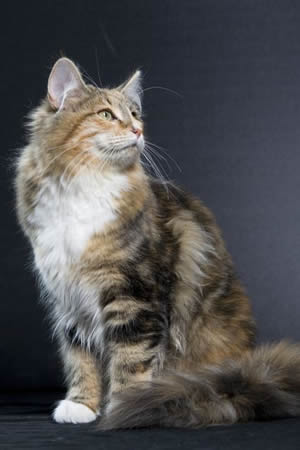Breed Standard
Head: Triangular shape with equal length and width. Flat forehead. Straight nose. The muzzle follows the line of the head; no whisker pinch. Nose of medium length. Strong, square rather than rounded chin; never pointed. Early Forest Cats had longer heads and their profile was not as straight as it is today.
Eyes: Large, almond shaped, and set at a slight angle. Any color is acceptable, but preferred colors are green or gold. White cats may be copper, blue, or odd-eyed.
Neck: Of medium length, muscular.
Body: Massive, robust, with a powerful appearance. Moderately long with a broad, rounded chest. Heavily boned and muscled.
Paw: Medium in length, muscular, and straight, with hind legs longer than the front legs, making the rump higher than the shoulders. Heavily muscled with substantial bone. Large, round paws with long tufts between each toe.
Tail: Of medium length, muscular.
Coat: Double coat. Medium long, with a very thick, wooly undercoat. The smooth, shiny, oily guard hairs are waterproof. The coat is uneven; shorter on the shoulders and becoming progressively longer on the back and flanks. The full ruff is comprised of the back-of the neck ruff, side mutton chops, and a full front bib. All colors permissible, except colorpoint, chocolate, and lilac, cinnamon, fawn, and Burmese patterns. Any amount of white is allowed.
Fault: Undersized, frail cat. Cobby or extremely long body. Round or square head. Nose break. Small ears. Small or round eyes. Delicate bone structure. Dry coat.
History
A peaceable wildcat with a long, thick coat The Norwegian Forest Cat has wandered Scandinavia for centuries. Many legends depict a large cat with a long, thick tail. According to Norse mythology, Thor, the most powerful god, was unable to lift this cat, and Freya's (the goddess of love and fertility) chariot was pulled by these cats. Though Norway is considered the country of origin of the "Fairy Cat", it is possible that the Vikings of the 13th century brought specimens back from Asia Minor (Caucus, Anatoly, etc.) to hunt the rats that infested their drakkars. Or perhaps Central European or Asian tribes traveling to Scandinavia before the Middle Ages introduced the cats. Cats brought in from other regions would have had to adapt to the extremely harsh climate of Scandinavia, and therefore, develop a thick, double, insulating, weather-proof coat. Their weight and size would have increased. Norwegian Forest Cats slowly moved from the wild to farms. Around 1930, Norwegian breeders began a selection program to preserve the breed and to combine hardiness and the beauty of its coat. Several specimens were shown in Oslo. The breed was recognized in 1972, and the first breed club and standard appeared in 1975. The F.I.Fe recognized the Norwegian Forest Cat in 1977. An official standard was written, then modified to avoid confusion with the Maine Coon Cat, for example the Nrcoon, a cross between a Norwegian Forest Cat and a Maine Coon. The first Forest Cats arrived in Germany and the United States in 1979, in Great Britain in 1980, and in France in 1982. Sweden is thought to maintain the highest population of Forest Cats. This breed meets great success in cat shows. Its wild, robust appearance and natural beauty are greatly admired.
Behavior
This extremely self-assured cat has a well-balanced temperament. A friendly, easygoing animal, the Norwegian Forest Cat is calm, though playful. He readily accepts other cats, dogs, and children, and his voice is soft. This hardy, robust, athletic cat is remarkably supple. Forest Cats mature slowly, not reaching full maturity until four or five years of age. Regular brushing and combing will maintain the beautiful coat and avoid snarls. During shedding season (the Forest Cat sheds heavily), daily brushing is required.
Health
Kidney and heart diseases have been reported in the breed. In an experiment directed by John C. Fyfea, Rebeccah L. Kurzhals, and others, it was concluded that a complex rearrangement in the breed's Glycogen branching enzyme (GBE1) can cause both a perinatal hypoglycemic collapse and a late-juvenile-onset neuromuscular degeneration in glycogen storage disease type IV in the breed. This disorder, while rare, can prove fatal to cats that have it. There are DNA tests available for GSD IV, and it is highly recommended (some cat associations obligate their Norwegian Forest cat breeder members) to carry out the DNA test before using such animals for breeding. PawPeds provide a pedigree database which comes together with health programmes, through publishing each single cat's test result, to provide useful information for breeders to make a well-informed breeding decision. The breed has also been known to suffer from hip dysplasia, which is a rare, partially hereditary disease of the hip joint.
Patella luxation is found more in the British Shorthair, Abyssinian and Devon Rex breeds, but it is recognized in Norwegian Forest cats as well. It is a condition in which patella moves out of its original physiological position.
A pedigree with 871 Norwegian Forest cats show that familial cardiomyopathy in this breed. There is also high prevalence of eosinophilic granuloma complex in Norwegian Forest cats which is suggestive of a genetic background.
The main factors causing Toxoplasma gondii seropositivity on cats are age, raw meat and outdoor access. A study shows that T. gondii seropositivity varies by cat breeds. Norwegian Forest cats have a relatively high rate of Toxoplasma gondii seropositivity (4.66%) comparing with other pure-bred cats (Birman: 4.16%, British Shorthair: 3.39%, Korat: 2.03%, Ocicat: 4.26%, Siamese: 2.57%), but slightly lower than Persian cats (6.99%).
Glycogen storage disease type IV due to branching enzyme deficiency was found in an inbred family of Norwegian forest cats.






